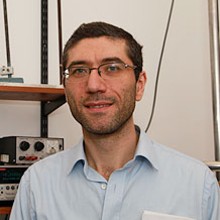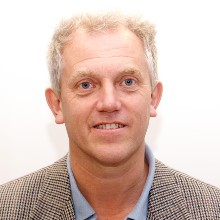Nanocomposites and novel dielectrics
Nanocomposites and novel dielectrics
Nanocomposites and novel dielectrics
Research groups associated with nanocomposites and novel dielectrics at Exeter
- Nano Engineering Science and Technology Group (NEST)
- Quantum Systems and Nanomaterials (QSN)
- Materials and Manufacturing Engineering (MME)
- Electromagnetic and Acoustic Materials (EMAG)
- Synthesizing 3D Metamaterials for RF, Microwave and THz Applications (SYMETA)
Contact us: metamaterials@exeter.ac.uk
Equipment and facilities
- Clean room facilities
- Graphene Centre
- Nanostructures measurement (liquid helium and low-temperature systems)
Case study
Professors
Professor Monica Craciun

Nanoscience and Nanotechnology
My research expertise spans across applied research in nanotechnology, electronic and optoelectronic devices to fundamental research in nanoscience (quantum phenomena, molecular electronics, nano electronics, spintronics) and materials science.
In particular, I am currently focused on the study of 2D materials such as graphene, functionalized graphene and layered dichalcogenides (e.g. MoS2, WS2), and of their hybrids with other emerging materials (e.g. organic semiconductors, perovskites). The aim is to create new materials and devices with unique electronic and optoelectronic properties not available in any other systems. In particular, we explore novel devices that can be used in emerging technologies such as electronic textiles, multifunctional smart coatings, or in a new generation of highly efficient solar cells and light emitting devices.
Professor Oana Ghita

High Temperature Polymeric Additive Manufacture
My research is focused on high performance polymers and composites and related manufacturing processes including conventional and new emerging manufacturing processes such as Additive Manufacturing (AM). My work concentrates on understanding the relationship between molecular structure/morphology, manufacturing and desired final properties.
In Additive Manufacture, I work in High Temperature Laser Sintering (HT-LS) and Free Form Fabrication (FFF) focused primarely on high performance, high temperature engineering polymers such as PEK, PEEK, medical grades of PEEK and PEKK as well as composites (glass, graphatised carbon, ceramic - fibres and fillers and CNTs reinforcement) and polymeric blends.
Please also see Exeter Technologies Group and Centre for Additive Layer Manufacturing (CALM) for more information.
Professor Alastair Hibbins

Manipulation of electromagnetic waves
Much of the work that I’m involved in seeks to manipulate electromagnetic waves using metamaterials. Some of our recent work has demonstrated that composite materials, with small (compared to the electromagnetic wavelength) resonant or scattering inclusions embedded within a passive host, offers exciting potential. We have explored how ferrite and carbon-iron micron-sized inclusions can yield magnetic behaviour beyond the frequency limits we normally expect. They offer the potential to fabricate impedance matched and absorbing materials in the GHz range, as well as benefiting microwave devices and antenna systems in this important part of the spectrum. This area of work is a collaboration with Dr Mustafa Aziz, and Profs Sambles and Ogrin - it includes analytical, modelling and experimental strands, with state-of-the art magnetic modelling systems (MaxLLG), and material characterisation facilities offering measurements up to 50 GHz.
Professor Geoff Nash

Optical and Acoustic Materials and Devices
Within the Nash group we explore the fascinating characteristics of new materials including 2D materials- for example, graphene and metasurfaces. We both investigate fundamental phenomena, such as the interaction of light with molecules, and aim to exploit these phenomena to create novel technology.
Professor Saverio Russo

Quantum Systems and Nanomaterials
My research group is pioneering the novel science found in nano-systems. In particular, we are currently studying the electrical properties of graphene materials, which are just one or few carbon atom thick with honeycomb structure. In these materials charge carriers have a record high mobility at room temperature and behave as massless Dirac fermions.
Our main research directions are
- Graphene-based flexible and transparent electronic devices;
- Novel technologies for fabricating suspended and double gated graphene transistors to access the electric field tuneable low-energy band structure in few-layer graphene and the electro-mechanical properties;
- Search for highly conductive and transparent materials;
- Superconducting-graphene hybrid structures.
Professor C David Wright

Active/Reconfigurable Metasurfaces; phase-change materials
Conventional metamaterials and metasurfaces (the 2D form of metamaterials) are ‘fixed-by-design’, with performance determined by the form of their resonating structures and the properties of the materials of which they are made. Far greater functionality and application would be available if we could develop active versions, i.e. metamaterials whose response can be dynamically adapted, tuned or reconfigured. At Exeter we are doing just this, using chalcogenide phase-change materials to deliver active optical metasurfaces that can work from the UV right out to the THz, and with applications ranging from LiDAR to multispectral imaging, optoelectronic displays, chemical sensing and much more.
Senior Lecturers/Senior Research Fellows
Dr Steve Hepplestone

Quantum mechanics and its applications to materials
At the atomic scale, we can engineer materials to have unusual properties not seen in the normal bulk material. To do this we have to understand and control the behaviour of individual atoms, particularly at the interface between two materials. Our research is focused on the atomic level manipulation and control of interfaces to both make new devices, and to better understand existing devices. This has application in several areas including energy storage (batteries), energy harvesting (thermoelectrics and solar), quantum metamaterials and 2D materials. We explore the role of electronic and thermal transport in materials, as well as optical properties and characterisation.
Dr Ian Hooper

RF and microwave metamaterials
The RF and mm-wave frequency bands are becoming ever more techologically important, with the ongoing push to increase data bandwith in wireless communications requiring the use of higher frequency radiation than was historically the case. As a result, novel devices to control the electromagentic environment at these frequencies are required, whether they be emitters and receivers (antennas), or absorbers, beam steerers, etc. In particular we are interested in devices that are reconfigurable and/or frequency-agile, and the role that metamaterials may have in such devices.
Dr David Horsell

Acoustic and thermal devices
We study the generation, control and interaction between sound, heat and electricity in materials. The focus of our experimental research is to study the fundamental physics of acoustic, thermal and electrical transport both within materials and across interfaces between materials. This has direct application in sound production, heat management in electronics, and improved efficiency of electronic devices. We also investigate the ways in which these properties can be used for active sensing, which includes detection of gas and fluids as well as electrical and thermal features of materials. Our work extends into biological systems, including biomimetics, thermoregulation in insects and electrical signalling in plants and animals.
Dr Ana Neves

Wearable technology
This line of research uses 2D materials, such as graphene, as active layers for a wide range of electronic devices based on flexible and textile substrates. These materials offer a wide range of properties of interest, allied to a very small size, lightweight and flexibility, which makes them ideal for truly wearable devices. These devices go well beyond bulky commercial accessories embedded in clothes and, when endowed with wireless communications, have an enormous transformative potential for applications such as remote healthcare or energy harvesting.

